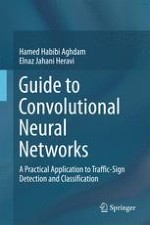2017 | OriginalPaper | Chapter
2. Pattern Classification
Authors : Hamed Habibi Aghdam, Elnaz Jahani Heravi
Published in: Guide to Convolutional Neural Networks
Publisher: Springer International Publishing
Activate our intelligent search to find suitable subject content or patents.
Select sections of text to find matching patents with Artificial Intelligence. powered by
Select sections of text to find additional relevant content using AI-assisted search. powered by
